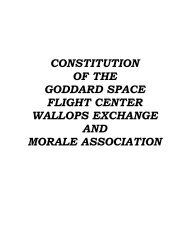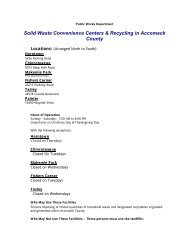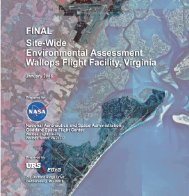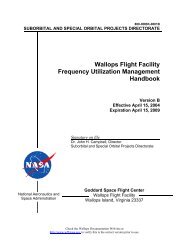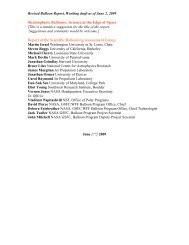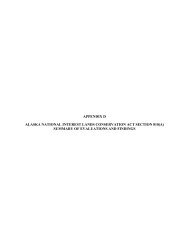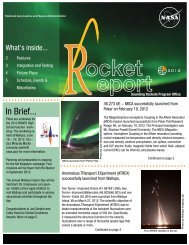operational missions & accomplishments - Wallops Flight Facility ...
operational missions & accomplishments - Wallops Flight Facility ...
operational missions & accomplishments - Wallops Flight Facility ...
Create successful ePaper yourself
Turn your PDF publications into a flip-book with our unique Google optimized e-Paper software.
WALLOPS<br />
OPERATIONAL MISSIONS<br />
& ACCOMPLISHMENTS<br />
Page 16<br />
SpaceX<br />
Research Range Services (RRS) personnel continue to<br />
be at the cutting edge of addressing tomorrow’s space<br />
transportation needs. RRS joined forces with NASA’s<br />
Johnson Space Center to support SpaceX’s Commercial<br />
Orbital Transportation Services (COTS) Demonstration<br />
<strong>Flight</strong> 1, SpaceX’s first launch under NASA’s COTS<br />
Program. The two-stage Falcon 9 expendable launch<br />
vehicle took flight from Cape Canaveral, Fla., December<br />
8, 2010, to deploy the Dragon spacecraft. The<br />
Dragon’s role on future launches will be to resupply<br />
the International Space Station (ISS) with supplies and<br />
eventually carry crew members to the ISS. NASA is<br />
partnering with commercial companies like SpaceX in a<br />
symbiotic and highly productive relationship to develop<br />
and demonstrate space transportation capabilities.<br />
The Dragon spacecraft separated from the second<br />
stage and demonstrated <strong>operational</strong> communications,<br />
navigation, maneuvering and reentry capabilities. For<br />
this demonstration flight, Dragon orbited the Earth<br />
as SpaceX tested all of its systems and subsequently<br />
initiated thruster firing to begin reentry, returning the<br />
Dragon capsule to Earth for a Pacific Ocean splashdown<br />
off the coast of California.<br />
Research Range Services provided command uplink,<br />
telemetry, and radar support throughout the mission.<br />
Powerful RRS antennas provided tracking, receiving, and<br />
processing of telemetry data and video from Dragon<br />
during the launch and subsequent orbit as it passed over<br />
the Research Range. RRS played a pivotal role in mission<br />
success by providing<br />
SpaceX back-up S-band<br />
Command Uplink support<br />
for the Dragon capsule<br />
and radar tracking during<br />
the launch and ascent<br />
phase and the first orbit<br />
to the U.S. Air Force’s<br />
Eastern Range.<br />
SpaceX conducted<br />
comprehensive<br />
tests of the Dragon<br />
spacecraft as it<br />
orbited the earth.<br />
Human Exploration and<br />
Operations Mission Directorate<br />
Research Range<br />
Services personnel<br />
provided command<br />
uplink, telemetry,<br />
and radar support<br />
throughout the<br />
mission for this Falcon<br />
9 expendable launch<br />
vehicle.<br />
Human Exploration and<br />
Operations Mission Directorate<br />
Space Shuttle Missions<br />
During fiscal year 2011, Research Range Services (RRS) personnel<br />
supported the final three Space Shuttle <strong>missions</strong>. Overall, more than<br />
400 passes were tracked with valuable data transmitted to Eastern<br />
Range controllers and Johnson Space Center (JSC) navigators as part<br />
of pre-launch, launch and on-orbit mission activities.<br />
The Range’s two main radars shared the workload of simultaneously<br />
tracking the Orbiter and the ISS during the rendezvous and<br />
separation phases of the mission. Without this tracking, the mission<br />
control team would not have had an independent tracking source<br />
during those final critical minutes to make performance assessments<br />
and, if necessary, an abort determination. Prior to each launch,<br />
Range tracking radars, telemetry, and command systems personnel<br />
worked with the Eastern Range controllers, Goddard Space <strong>Flight</strong><br />
Center (GSFC) network managers and JSC navigators to ensure RRS<br />
system readiness.<br />
Voice circuits were thoroughly tested with<br />
GSFC and JSC prior to launch to ensure<br />
critical backup communications with the<br />
Orbiter in the event of an emergency.<br />
Did You Know...<br />
For most Shuttle Missions, the Research Range<br />
Services Program setup emergency landing<br />
procedures in the event the Shuttle had to land<br />
at <strong>Wallops</strong> <strong>Flight</strong> <strong>Facility</strong>. If a shuttle had to abort<br />
take off within the first 12 seconds of launch, the<br />
Orbiter could have been directed to <strong>Wallops</strong>.<br />
WALLOPS<br />
OPERATIONAL MISSIONS<br />
& ACCOMPLISHMENTS<br />
Operation Date Mission<br />
STS-133 24 Feb. 2011 -<br />
9 Mar. 2011<br />
STS-134 16 May 2011 -<br />
1 June 2011<br />
STS-135 8 July 2011 -<br />
21 July 2011<br />
Discovery’s 39th<br />
and final mission.<br />
Crew delivered<br />
the Permanent<br />
Multpurpose<br />
Module Leonardo<br />
to the ISS<br />
Endeavour’s 25th<br />
and final flight.<br />
Crew delivered the<br />
Alpha Magnetic<br />
Spectrometer<br />
and the ExPRESS<br />
Logistics Carrier to<br />
the ISS<br />
Atlantis flew the<br />
Space Shuttle<br />
Program’s final<br />
mission. Primary<br />
cargo was the<br />
Multipurpose<br />
Logistics Module<br />
Raffaello to the ISS<br />
Page 17



